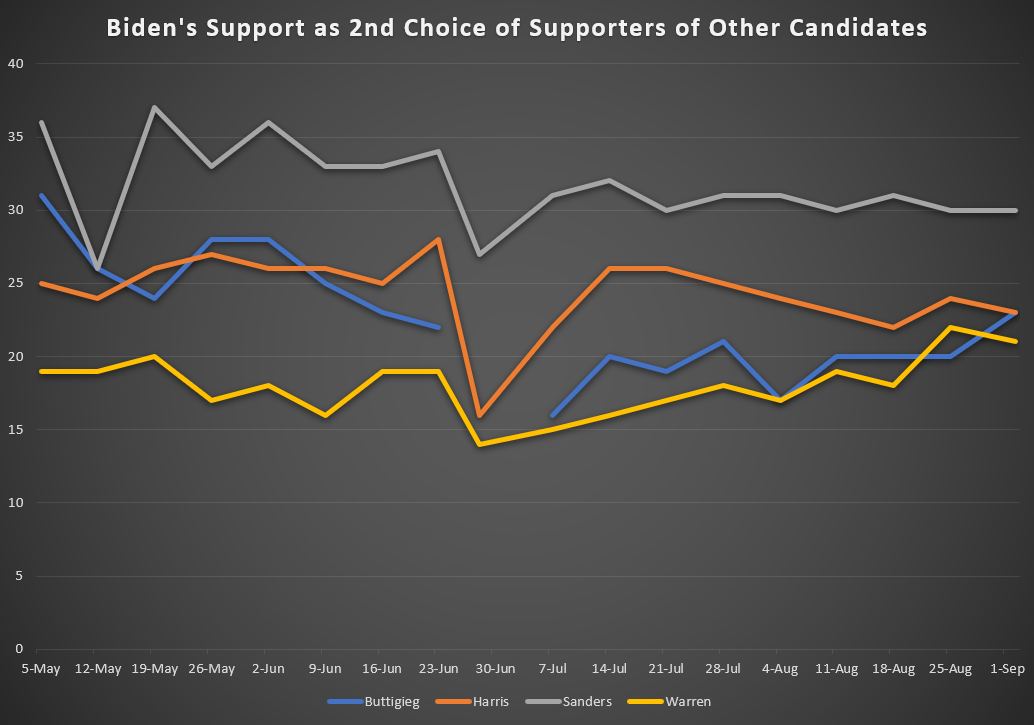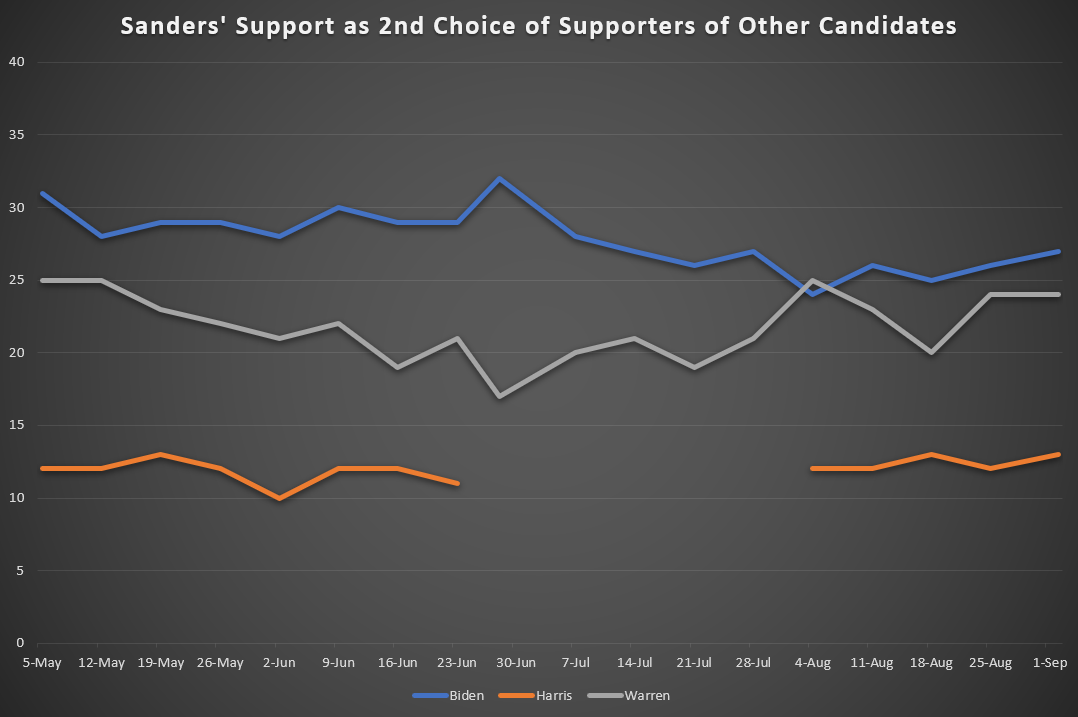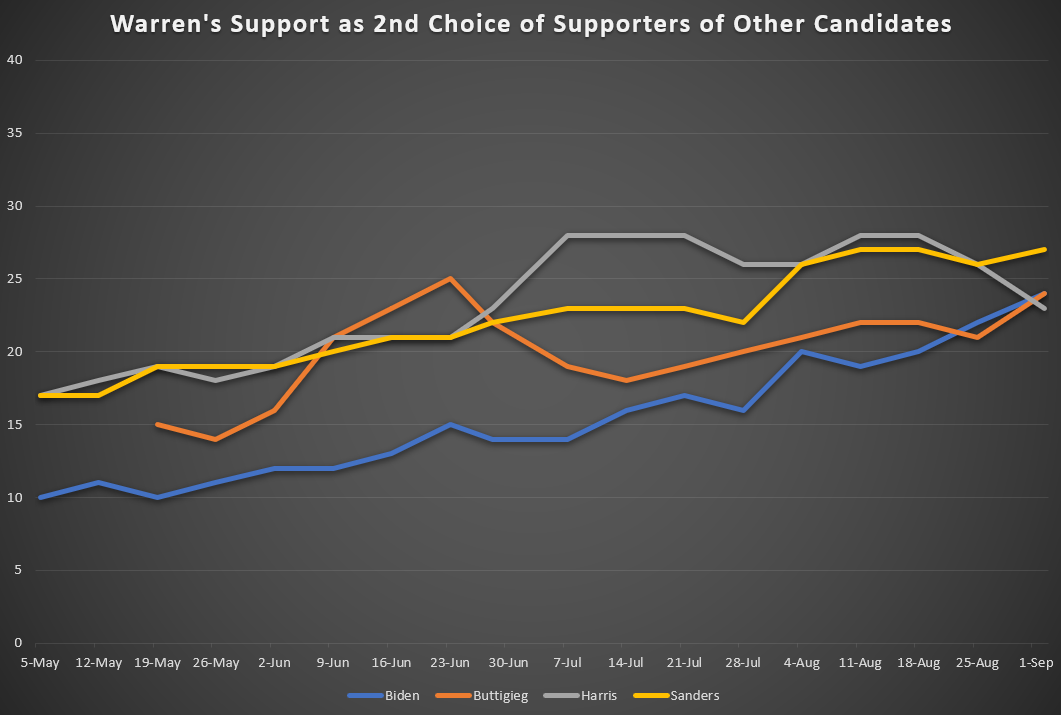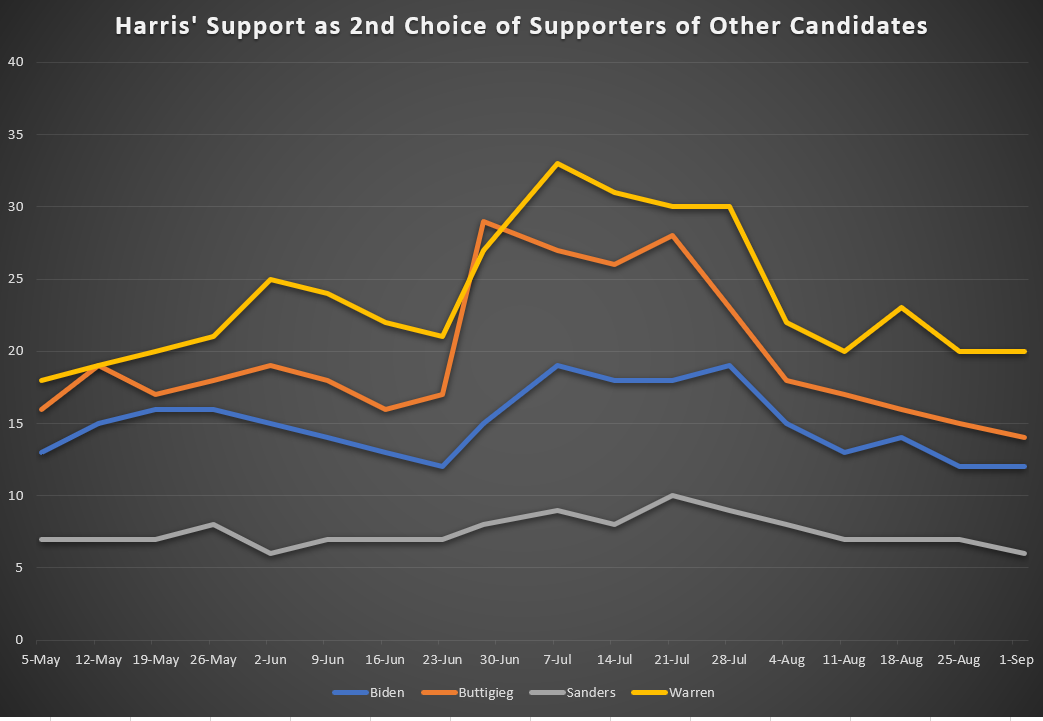For the last several months, global survey research firm Morning Consult has been conducting a weekly tracking poll of the Democratic presidential primary. Every week, the site is updated with the results of the previous week’s survey of nearly 17,000 registered voters throughout the United States.
I can’t speak to the accuracy of the poll. However, it provides a rather unique piece of info that most other polls don’t. After respondents indicate who they would vote for in the primary, they are then asked who their second choice would be. Morning Consult then uses the results of this survey question to assemble a list for each of the top 5 candidates, showing the top 3 most popular second choices.
For example, for the survey conducted August 26th through September 1st, the top 3 second choice candidates for supporters of Joe Biden were:
- Bernie Sanders: 27%
- Elizabeth Warren: 24%
- Kamala Harris: 12%
Assuming this is accurate, we could say that if Biden were to drop out of the race this week, Sanders would benefit the most, picking up more than a quarter of Biden’s supporters. Warren would be running a close second, and Harris a distant third. Buttigieg, O’Rourke, and the remaining candidates would be largely left out in the cold.
Why does this matter?
The candidate who wins the presidential primary will be the one that can most effectively draw support away from other candidates.
Looking at the above breakdown of who Biden’s supporters would shift to if Biden were out of the race, you’d much rather be in Sanders’ shoes versus Harris’s, right? If Biden fell down a flight of stairs tomorrow, Sanders would pick up the biggest chunk of votes and would vault into a distant first place. Harris would get a bump, but she would actually lose ground to both Sanders and Warren.
For someone to be a winning candidate, they have to be quite the carnivore, capable of feeding on not only the remains of their dead and dying competitors—that is, those who have either already dropped out (e.g. Gillibrand) or whose campaigns are flaming out (e.g. Buttigieg and O’Rourke)—but also those that are relatively healthy.
Any candidate with a decent chance of winning should not only be the first choice of a decent chunk of voters, but also have strong support as a second choice.
Why can’t candidates just draw on the support of voters who haven’t yet decided on a candidate?
Well, because there aren’t enough of them. As of this writing, the most recent high quality poll was conducted by Quinnipiac in late August. In that poll, only 9% of respondents stated they were undecided. That’s not a big enough piece of the pie for anyone to catch up to Joe Biden, even if they picked up every undecided voter.
But what about if a candidate could pick up supporters from just the really weak candidates that are likely to drop out before primary voting starts? Well, over the last few weeks of polling, only an average of about 25% of people either stated they were undecided, or voiced support for someone other than Biden, Sanders, Warren, and Harris. 25% is a big chunk of support.
But generally speaking, when undecided voters make a choice, as a rule of thumb they tend to divide proportionally according to the amount of support candidates get from already-decided voters. Meaning, if 75% of voters say they like Candidate A, and 25% say they like Candidate B, any remaining undecided voters will roughly split in a 3:1 ratio between A and B.
This means that Biden will probably pick up about a third of that remaining 25% of voters. Thus, again, candidates have to be capable of pulling supporters from strong candidates. Barack Obama didn’t defeat longtime front runner Hillary Clinton in 2008 by picking up undecided voters. He did it by swaying a considerable number of Clinton’s supporters over to his side.
If a candidate has weak support as a second choice candidate, then they have very low odds of swaying enough previously decided voters over to their side. They need to be a top second choice in order to eventually become a top first choice.
With this in mind, I’ve been tracking the results of Morning Consult’s second-choice surveys every week for the past several months, and trends are beginning to become apparent. These trends likely speak to the overall health the candidates’ respective campaigns.
Bear in mind, looking at the second choices of a candidate’s supporters is a rather fuzzy piece of analysis. Consider, for instance, looking at changing trends in the second choices of Kamala Harris’s supporters between July 8th and August 8th. On July 8th, her average polling support was 16%. On August 8th, it was 8%. During that time, looking at the behavior of her supporters, you might see their support of Joe Biden drop over that one-month period. But that might well be because those voters were more likely than others to defect away from Harris, and thus they comprised a smaller share of Harris’ base by August 8th.
This means that in looking at second-choice trends, we have to be a little careful. That being said, let’s dive into each candidate’s secondary support.
(Please note, you will see gaps in the data. This is because Morning Consult only provides data for the top 3 second choices. Thus, if someone dropped to 4th or lower, there’s no data to draw on. This is also why you won’t see a discussion of Buttigieg or O’Rourke, as neither of them has ranked as a top-3 choice for any of the major candidates in the last several months.)
Joe Biden’s standing in the race may have eroded slightly, but he’s still solid as a second choice candidate.

There’s clearly been a bit of a decline in support for Biden from Sanders and Harris supporters. Biden peaked at about 37% with Sanders voters, but has dropped to 30% to 32% for the last month. He briefly peaked at about 28% with Harris supporters, but is currently at 23%.
There was a notable decline with Buttigieg supporters, but Biden has recovered quite a bit with them in the last couple weeks. However, given that Buttigieg has such a small share of voter support currently, Biden’s standing with them isn’t terribly important.
But interestingly enough, Biden has improved with Warren supporters. After being stuck below 20% for months, he’s now bouncing around 21% to 22%. However, this increase may be due to Biden supporters defecting to Warren, but still keeping Biden in their back pockets.
In general, Biden is looking pretty strong. His lowest base of secondary support has risen. He largely bottomed out around June 30th, but since then he’s improved with supporters of 3 of his 4 major opponents. Given that he’s currently leading the race by a large margin, he’s in very good shape all around.
Sanders has remained pretty flat, but his strength as a second-choice is pretty comparable to Biden’s.

Sanders’ lowest level of support is definitely much weaker than Biden’s.
You may have noticed that Buttigieg’s supporters don’t show up on this chart. That’s because in the last 4 months of tracking Buttigieg supporters, Sanders has only been a top-3 second choice once. But given that Buttigieg’s share of support is only about 4.5%, that’s no big loss for Sanders.
His support is also quite weak with Harris supporters. It’s increased ever so slightly, but is still a paltry 13%.
But his support with Biden and Warren voters is excellent. He’s declined slightly with Biden supporters, but is still at 27%. And while he dipped for a while with Warren supporters, he’s recovered nicely, nearly matching his high.
A lot of candidates would love to be in Sanders’ shoes.
Warren is unique—she is the only candidate that has shown an increase across the board in support from other candidates’ supporters.

Warren’s growth as a second-choice is nothing short of incredible. On May 5th, her highest level of support was 17%, from Harris and Sanders supporters. As of September second, her lowest level of support is 23%, with Harris supporters.
What really warrants looking at is her growth with Biden supporters. She went from 10% in early May to nearly 25%. That’s huge, especially given that Biden currently has the lion’s share of the Democratic base. Making inroads with that pool of voters is huge. We can perhaps better illustrate her success by looking at how the preferences of Biden’s supporters has changed over time:

Keep in mind, this chart shows kind of the inverse of what the other graphs show. Here, we’re looking only at current Biden supporters, looking at who their top second choices are. Back in May, as I said previously, Warren was at 10%, behind Harris at 13% and Sanders over 30%. Today, Sanders is still in the high 20s. And unfortunately for Harris, she is still pretty much stuck where she was at 4 months ago.
But Warren has steadily climbed very steadily, making consistent progress. She’s currently at her all-time high, and she is now threatening Sanders’ position as the top 2nd choice.
A similar trend is evident when looking at Sanders supporters:

Warren’s growth here isn’t quite as profound as with Biden supporters. But she is no longer a distant second place, as she was months ago. In early May she was at 17%. Now she’s at 27%.
Elizabeth Warren has immense potential, and warrants very, very close examination in the coming months.
Harris showed serious strength back in July, but she has since regressed back to where she started.

Kamala Harris has to feeling a bit like Sisyphus at the moment. Back in June, in the wake of her performance in the first debates, she vaulted up in the polls, and that showed in her growth as as second choice as well. But that support has since eroded, and now she is more or less back where she started.
If you’re Joe Biden polling at an average of 30%, being roughly flat as a second-choice candidate is fine. But Harris is currently polling at 7%. She has a ton of ground to make up. And if you scroll up to the line graphs of the second-choice preferences of Biden’s and Sanders’ supporters, you can see that she is a distant third with both of them. Given that Biden and Sanders currently combine for a hair under 50% of the vote, that’s baaaaaaaaaad.
Let’s put it another way. Based upon this data, I’ve calculated how Sanders, Warren, and Harris would be faring in the polls if Biden dropped out, along with every other candidate, so that it was a 3-way race:
- Sanders: 42.2%
- Warren: 39.2%
- Harris: 18.6%
In that scenario, she would be completely hosed, the third wheel in a brawl between Sanders and Warren.
The situation is even more grim for her if Sanders were to drop out, and it was a race between Biden, Warren, and she:
- Biden: 54.9%
- Warren: 32.6%
- Harris: 12.5%
In all honesty, I think this is already a 3-way race. And Harris isn’t in it. Looking at the second-choice preference polling makes that obvious.